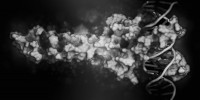
SP7 Transcription Factor in Bone Formation
Bones are formed through two processes: endochondral or intramembranous ossification. The development and maintenance of bones require the regulation of transcription factors (TFs), which are proteins that regulate gene expression. Several master TFs have crucial roles in regulating bone formation, resorption, and remodeling. One such TF is Osterix/SP7, which is detected in chondrocytes, hypertrophic chondrocytes, osteoblasts, and osteocytes. It is considered an essential regulator of osteoblast differentiation and bone formation. However, recent studies suggest novel roles in chondrocyte and osteocyte development and function. A new review summarizes the function of SP7 in bone formation and remodeling. Thereby, it focuses on recent studies on SP7 in human skeletal disease and its future therapeutic potential for bone health.
SP7 is expressed in various tissues, including bone, tooth, brain, and the reproductive tract. It plays a crucial role in osteoblast differentiation and bone formation, with studies showing that Sp7-null mice lack ossification. The transcription factor also regulates osteocyte maturation and intracortical remodeling through osteocyte target genes. In addition, SP7 regulates chondrocyte differentiation and endochondral ossification. The article also discusses how it forms transcriptional complexes with other co-factors to control cell-specific gene expression. Furthermore, the authors talk about how it acts upstream to directly regulate the osteocyte-specific gene Sost.
The review points out that SP7 plays a critical role in chondrocyte differentiation and endochondral ossification, odontogenesis, and cementogenesis. Studies show that the transcription factor regulates the expression of several chondrocyte genes. In addition, it controls the differentiation and maturation of odontoblasts, ameloblasts, and cementoblasts. Genetic studies have identified SP7 as a locus associated with bone mineral density in osteoporosis. Further investigation of SP7's role in bone and tooth development can lead to novel therapeutic strategies for periodontal regeneration and alveolar bone healing.
Transcription factor SP7's abnormal expression linked to osteosarcoma and breast cancer metastasis
SP7's abnormal expression can trigger mesenchymal stem/stromal cells and/or osteoblastic precursors to form the osteosarcoma microenvironment by producing an excessive osteoid matrix. SP7 expression is also elevated in human breast cancer cell lines and tumors of some breast cancer patients, promoting skeletal metastasis. The transcription factor also plays a role in the extracellular matrix production of cancer-associated fibroblasts (CAFs), derived from Osx+ cells in the bone marrow, contributing to tumor progression. Future studies are necessary to evaluate the correlation between SP7 and oncogenes, tumor suppressor genes, and the microenvironment in bone metastases and osteosarcomas. Therapeutic approaches to targeting SP7-dependent genes, such as Ostn, may represent attractive therapeutic targets for bone loss due to glucocorticoid treatment.
Check out more studies here.